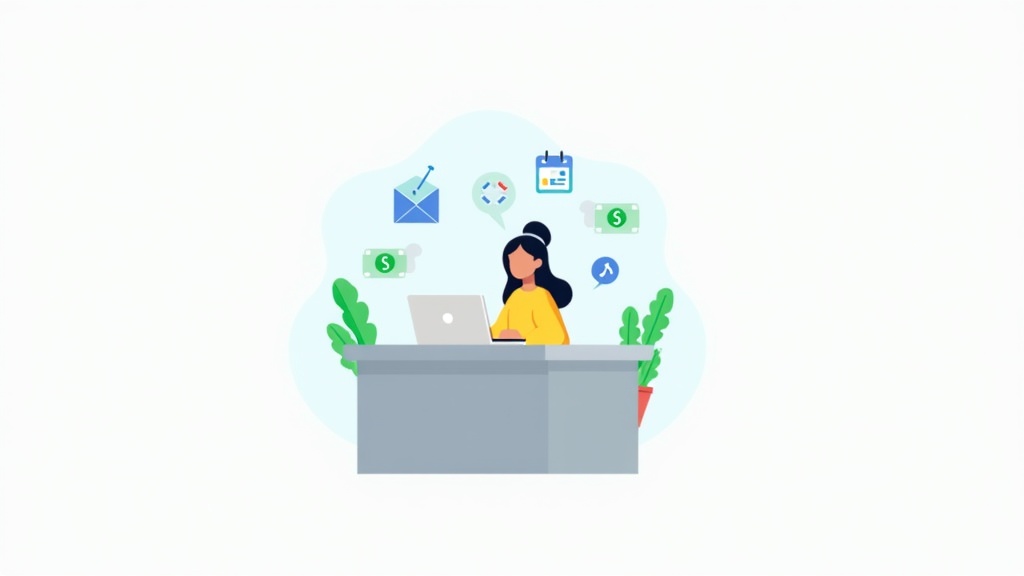Affiliate marketing is one of those online business ideas that feels both accessible and pretty exciting if you’re new to making money online. Imagine earning commissions just by recommending products you actually like or believe in, without having to create your own products or handle customer support. This guide will walk you through everything you need to know about affiliate marketing so you can decide if this path is worth trying for yourself. No prior marketing background required.

Understanding Affiliate Marketing: The Basics
Affiliate marketing is all about promoting someone else’s product or service and earning a piece of the sale price when people buy through your unique referral link. Companies create special tracking systems to know when you, the affiliate, send them a customer. In exchange, you get a commission, which can add up over time if you’re sharing products people actually want to buy.
This approach has been around for a while, and it keeps growing because it helps both businesses (who get more customers) and people like you (who earn commissions on successful referrals). According to Influencer Marketing Hub, the affiliate marketing industry is estimated to be worth over $17 billion globally as of 2023. That’s a lot of opportunities out there!
Affiliate marketing is popular with bloggers, YouTubers, social media creators, and anyone who likes sharing their favorite products with an audience. You don’t have to be a technical wizard or a sales expert, but it helps to understand how things work before jumping in.
How Affiliate Marketing Works, Step by Step
If you want to get a picture of what goes on behind the scenes, the affiliate marketing process generally looks like this:
- Sign Up for an Affiliate Program: Big companies like Amazon, Shopify, and Booking.com all offer affiliate programs. You fill out a simple application (usually free), and once approved, you get special tracking links to share.
- Choose Products or Services to Promote: Pick stuff that fits your interests, content, or audience. The more relevant it is, the easier it’ll be to get people clicking your links.
- Share Your Unique Links: You can add affiliate links in blog posts, social media updates, YouTube video descriptions, or even in emails to your subscribers. Just make sure you’re following the program’s rules about where and how you can post links.
- Earn Commissions on Sales or Actions: When someone clicks your affiliate link and completes an action (like making a purchase or signing up for a free trial), you earn a commission. Payments could hit your bank account monthly, biweekly, or sometimes as soon as you’ve earned a certain minimum amount.
It doesn’t require tons of technical skills. If you can copy and paste a link, you’re already halfway there.
What Kinds of Affiliate Programs Are Out There?
It’s worth knowing there are several types of affiliate programs, each with different commission structures. Here are the main options you might run into:
- Pay per sale (PPS): You get paid each time someone buys a product after clicking your link. This is super common (think Amazon Associates or Nike’s affiliate program).
- Pay per click (PPC): These programs pay you every time someone clicks your link, even if they don’t buy anything. These tend to pay less per click compared to other structures.
- Pay per lead (PPL): Some programs pay when your referral completes an action short of a purchase, like registering for a free account or submitting their email. This is popular in fields like finance or SaaS tools.
Some programs offer recurring commissions, meaning you keep getting paid as long as the customer keeps their subscription, while others are one-time. Always check the program rules before getting started.
What to Look for When Choosing Affiliate Products
Your results in affiliate marketing depend a lot on what you choose to promote and how you match it with the right people. Here are the main things I always recommend looking at first:
- Product Quality: If you wouldn’t use it yourself, it’s probably not a great fit. Recommending low quality stuff can damage your reputation fast.
- Commission Rates: Typical rates fall anywhere from 1% (for mass market retailers) to upwards of 50% for digital products or online courses. Don’t chase high commissions if the product won’t convert, though.
- Cookie Duration: The “cookie” is a tracking file placed on the customer’s browser after they click your link. Longer cookie windows (like 30-90 days) give you a better chance to earn credit for a sale made later, not just right away.
- Payout Structure: Look for clear information on how and when you’ll get paid. Programs that pay reliably and on time are always worth checking out.
- Program Reputation: Read reviews and see what other affiliates are saying before you jump in. If payment complaints are common, it’s best to move on.
Getting Started with Affiliate Marketing: A Beginner’s Checklist
You don’t need a giant blog or hundreds of followers to start with affiliate marketing, but it helps to have a bit of a plan. Here are some first steps that make the whole thing smoother:
- Pick Your Niche: Focus on a specific topic or audience that you can speak to with real knowledge. It’s easier to grow trust, and results, if you genuinely care about what you’re recommending.
- Set Up a Platform: Most people start a blog or YouTube channel, but you can also use social media (TikTok, Instagram), email newsletters, or even podcasts.
- Sign Up for Affiliate Programs: Look for programs related to your niche and apply to join. For beginners, Amazon Associates, ShareASale, and CJ Affiliate are all worth exploring.
- Create Content: Make reviews, tutorials, or best of lists that naturally include your affiliate links. Clear, honest recommendations usually perform best.
- Disclose Your Affiliate Links: Trust is super important. Always let your readers, viewers, or followers know when a link is an affiliate link. This is required by law in many places and keeps you above board.
- Analyze and Improve: Use tracking tools to see which links are performing. Adjust your approach based on what works and ditch what doesn’t.
Common Challenges You Might Face
Affiliate marketing sounds pretty simple, but there are a few bumps along the way. If you know what to expect, it’s a lot easier to handle them:
- Low Initial Earnings: It can take time to see your first commissions, especially if you’re just starting out and building traffic. Don’t get discouraged if things look slow at first.
- High Competition: Popular topics like tech gadgets, fitness, or beauty have lots of affiliates fighting for attention. Focusing on a unique angle or underserved subniche can help.
- Keeping Trust: Promoting too many products (or stuff that doesn’t fit your audience) can confuse readers or make you seem pushy. Balance your recommendations with genuine, useful content.
- Program Changes: Commission rates and rules can change with little notice. Stay updated with your programs and mix in some variety just in case.
Why Trust Matters in Affiliate Marketing
I’ve seen firsthand that trust can make or break your results as an affiliate. If people know you’re honest and only recommend things you stand by, they’re much more likely to use your links, and come back for more advice in the future! So, focus on building longterm audience relationships, not just quick wins.
Advanced Tips Once You Get Going
After you’ve got the basics down, you might want to give a boost to your affiliate earnings further. Here’s what you can try:
- Take Up a Notch Your SEO: Optimizing your content for search can help more people find your reviews or guides when they’re actually looking to buy. Focus on including relevant keywords, maintaining easy readability, and spotting what top performing content is doing—then try to add your own unique take.
- Build an Email List: Having email subscribers lets you follow up with offers and build more personal connections. This is a great way to boost repeat clicks and sales. Consider offering a freebie (like a checklist or short guide) to encourage people to sign up.
- Test Different Content Formats: Video, comparison charts, or interactive tools often convert better than plain text. Try a few options and see what your audience likes. For instance, videos can help put a face to the recommendation, while interactive quizzes might engage readers and help them pick the right product.
- Track Conversions: Use Google Analytics or built in program trackers to keep tabs on what content leads to the most sales. Double down on what works best and see if you can copy that approach into other content pieces.
Affiliate Marketing in Everyday Life: Real Examples
To make it feel less abstract, here’s how affiliate marketing shows up in the real world:
- Tech Blogger: Writes honest reviews about laptops and includes affiliate links to stores like Best Buy or Amazon. Earns a commission when readers buy through those links.
- Fitness YouTuber: Shares workout routines and links to recommended protein powders or gear. Commission comes in every time a subscriber orders.
- Travel Instagrammer: Posts about unique places to stay and uses affiliate links to hotel booking sites. Followers who book rooms through those links help the creator earn a cut.
Affiliate marketing works pretty much anywhere people are researching or buying products online. The key is matching what you share with what your audience actually cares about. For example, even lifestyle bloggers or niche experts in hobbies like gardening or crafts frequently find success by recommending tools and supplies they trust.
Frequently Asked Questions
Here are some questions I get from new affiliate marketers:
Question: Do I need a website to get started?
Answer: A website or blog helps, but it’s not required. Social media, YouTube, or even email can be enough for some programs. It depends on the affiliate network.
Question: Can I do affiliate marketing part time?
Answer: Absolutely. Many people start while working a regular job. It might take a bit longer to see results part time but it’s totally possible.
Question: How do I know if an affiliate program is legit?
Answer: Look for clear terms, real company information, and online reviews. Avoid anything asking for high fees upfront or making outlandish income claims. It also helps to track down feedback from other affiliates to see if payments are delivered reliably and on time.
The Takeaway: Getting Started with Affiliate Marketing
Affiliate marketing offers a pretty straightforward way to earn money online, whether you want a little side cash or a full time gig. By choosing programs and products that fit your interests, and putting trust first, you can build something that helps both your audience and your wallet.
Take a little time to check out the options, try a few different approaches, and keep tweaking your strategy. With patience and steady effort, affiliate marketing can turn into something you’re genuinely proud of. Wrapping up, if you stay focused on honesty and value, the benefits of affiliate marketing can stick with you for the long haul.
